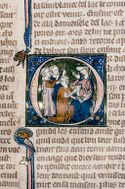Illuminated Poetry: Difference between revisions
JStallings (talk | contribs) (created page) Tag: visualeditor |
JStallings (talk | contribs) No edit summary Tag: visualeditor |
||
| Line 1: | Line 1: | ||
[[File:The Romance of Lancelot du Lac.jpg|alt=Pharien seeking counsel from King Claudas about his wife's infidelity with the king (S III 23/8-11).|thumb|French illuminated manuscript, c. 1330]] | For this exercise you and a partner will be illuminating a poem or short prose piece by expressing the tone, metaphor, and imagery of the work visually. As you read over the assignment, be thinking about what works have spoken to you in the past, or speak to your teacher or librarian for recommendations. A few resources at the bottom of the page are offered for inspiration as well. In the end, you will create a single, 10" x 15" page combining the text of the original work and your art.[[File:The Romance of Lancelot du Lac.jpg|alt=Pharien seeking counsel from King Claudas about his wife's infidelity with the king (S III 23/8-11).|thumb|French illuminated manuscript, c. 1330|189x189px]] | ||
== History == | == History == | ||
Making copies of a written work took much time and effort before the invention of the printing press. Before then, each page of a book was handwritten by scribes or monks. Particularly important works for the church or wealthy patrons were ''illuminated'' with bright colors and gold leaf. The page to the right is from ''The Romance of Lancelot du Lac'', written in France around 1300. The page might look like an ancient children’s book, complete with illustrations. This is appropriate because both words (“illuminate” and “illustrate”) come from the Latin ''illustrationem'', meaning “vivid representation.” | Making copies of a written work took much time and effort before the invention of the printing press. Before then, each page of a book was handwritten by scribes or monks. Particularly important works for the church or wealthy patrons were ''illuminated'' with bright colors and gold leaf. The page to the right is from ''The Romance of Lancelot du Lac'', written in France around 1300.<ref>"Romance of Lancelot du Lac (branches 3. Lancelot; 4. Queste; 5. Mort Artu)." Bodley Library, Oxford.</ref> The page might look like an ancient children’s book, complete with illustrations. This is appropriate because both words (“illuminate” and “illustrate”) come from the Latin ''illustrationem'', meaning “vivid representation.”<ref>"Illustration." ''Online Etymology Dictionary.'' Ed. Douglas Harper. 2016.[http://www.etymonline.com/index.php?term=illustration&allowed_in_frame=0]</ref> Other impressive historic examples include the [http://digitalcollections.tcd.ie/home/index.php?DRIS_ID=MS58_003v Book of Kells] and William Blake's [http://siteslab.unc.edu/viscomi/illword/ illustrations] from his books of poetry. | ||
== Contemporary Examples == | |||
These frames come from Craig Thompson’s graphic novel [https://www.amazon.com/Blankets-Craig-Thompson/dp/1891830430 Blankets]. The first is close to a classic illuminated page in that the words are represented in the picture; the words are illuminated by the corresponding image. The second, at the bottom of the page, expands upon the metaphor “to burn my memories” by actually representing the character becoming enflamed. | |||
[[File:Blankets59.png|left|thumb|285x285px|from Craig Thompson's ''Blankets'', 59]] | |||
<references /> | |||
[[Category:Assignments]] | [[Category:Assignments]] | ||
[[Category:Language Arts]] | [[Category:Language Arts]] | ||
Revision as of 10:29, 8 July 2016
For this exercise you and a partner will be illuminating a poem or short prose piece by expressing the tone, metaphor, and imagery of the work visually. As you read over the assignment, be thinking about what works have spoken to you in the past, or speak to your teacher or librarian for recommendations. A few resources at the bottom of the page are offered for inspiration as well. In the end, you will create a single, 10" x 15" page combining the text of the original work and your art.
History
Making copies of a written work took much time and effort before the invention of the printing press. Before then, each page of a book was handwritten by scribes or monks. Particularly important works for the church or wealthy patrons were illuminated with bright colors and gold leaf. The page to the right is from The Romance of Lancelot du Lac, written in France around 1300.[1] The page might look like an ancient children’s book, complete with illustrations. This is appropriate because both words (“illuminate” and “illustrate”) come from the Latin illustrationem, meaning “vivid representation.”[2] Other impressive historic examples include the Book of Kells and William Blake's illustrations from his books of poetry.
Contemporary Examples
These frames come from Craig Thompson’s graphic novel Blankets. The first is close to a classic illuminated page in that the words are represented in the picture; the words are illuminated by the corresponding image. The second, at the bottom of the page, expands upon the metaphor “to burn my memories” by actually representing the character becoming enflamed.

